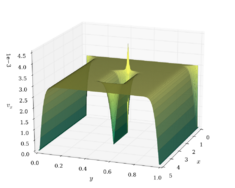Separable partial differential equation
| Differential equations |
|---|
 |
| Classification |
| Solution |
A separable partial differential equation is one that can be broken into a set of separate equations of lower dimensionality (fewer independent variables) by a method of separation of variables. This generally relies upon the problem having some special form or symmetry. In this way, the partial differential equation (PDE) can be solved by solving a set of simpler PDEs, or even ordinary differential equations (ODEs) if the problem can be broken down into one-dimensional equations.
The most common form of separation of variables is simple separation of variables in which a solution is obtained by assuming a solution of the form given by a product of functions of each individual coordinate. There is a special form of separation of variables called -separation of variables which is accomplished by writing the solution as a particular fixed function of the coordinates multiplied by a product of functions of each individual coordinate. Laplace's equation on is an example of a partial differential equation which admits solutions through -separation of variables; in the three-dimensional case this uses 6-sphere coordinates.
(This should not be confused with the case of a separable ODE, which refers to a somewhat different class of problems that can be broken into a pair of integrals; see separation of variables.)
Example
For example, consider the time-independent Schrödinger equation
for the function (in dimensionless units, for simplicity). (Equivalently, consider the inhomogeneous Helmholtz equation.) If the function in three dimensions is of the form
then it turns out that the problem can be separated into three one-dimensional ODEs for functions , , and , and the final solution can be written as . (More generally, the separable cases of the Schrödinger equation were enumerated by Eisenhart in 1948.[1])
References
- ↑ Eisenhart, L. P. (1948-07-01). "Enumeration of Potentials for Which One-Particle Schroedinger Equations Are Separable". Physical Review (American Physical Society (APS)) 74 (1): 87–89. doi:10.1103/physrev.74.87. ISSN 0031-899X.
 |
